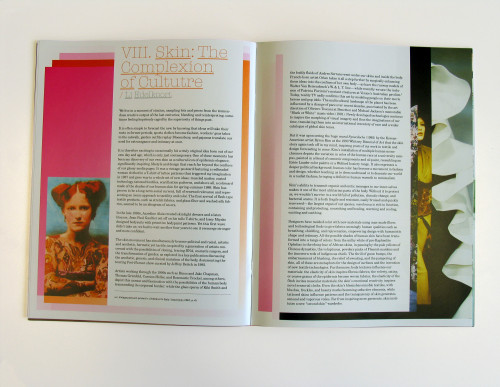
Skin Tight: The Sensibility of the Flesh
Two, Saint Paul, Minnesota, 2004
Description
Skin Tight was designed for museum visitors, fashion aficionados and designers of all types, as a visual record of the exhibition. The client simply wanted a beautiful, four-color, lavish-as-possible catalog befitting the high-powered fashion designers represented in the exhibition—all done, of course, on the typically anemic budget circumstances sadly suffered by nonprofit arts institutions in this country. Saddle-stitching—usually reserved for cheaper publications (as opposed to perfect binding)—was employed for part of the book and combined with an overall binding that involved (what else) a “skintight” rubber band and a snug plastic Ziploc bag. These cheaper binding techniques allowed us to use four-color process lavishly throughout the book.
Ten au courant powerhouses of fashion design were selected for the exhibition and accompanying publication. In addition to essays by contemporary fashion editors and critics, the publication included 15 to 100 images submitted by each designer for their representation in the book. Our immediate question was, how do we design the cover so as not to offend any one of the designers?
To solve the problem of the cover, we made double-sided spreads for each fashion house, leaving them unbound from the interior essay section. This strategy allowed each designer his or her own cover. An elegant white rubber band served to bind the spread-posters around a saddle-stitched midsection. The entire book remained untrimmed to allow “gutter creep” so that images colorfully spill out from the trim. Within the interior bound pages, colorful boxes and snippets of imagery shuffle around the perimeter of the essays to mirror the idea that the cover can also be shuffled in different orders, allowing the reader to decide which designer he or she wishes to display on the cover.
Credits
- Design firm
- Two
- Art directors
- Deborah Littlejohn, Santiago Piedrafita
- Designers
- Deborah Littlejohn, Santiago Piedrafita, Zachary Ohlman
- Photographers
- Jean Francios Carly, Marleen Daniels, F. Dumoulin, Anders Edström, Carmen Freudenthal, Takashi Homma, Jeff Jacobs, Dan Lecca, Bertrand Marignac, Mamoru Miyazawa, Chris Moore, Huw Morgan, Clare Robertson, Chris Rugge, Justin Smith, Peter Stitger, Ronald Stoops, Etienne Tordoir, Elle Verhagen, Marcel van der Vlugt
- Production artists
- Deborah Littlejohn, Santiago Piedrafita, Zachary Ohlman
- Authors
- Sylvia Chivaratanond (curator), Frederic Bonnet, Caroline Evens, Gerdi Esch, Gillian Carrara, Li Edelkoort
- Editor
- Kari Dahlgren
- Publisher
- Museum of Contemporary Art, Chicago
- Trim size
- 8 x 10 inches
- Pages
- 64
- Quantity printed
- 2,000
- Typefaces
- TYP 1451A and 1454B (by Cornell Windlin), ITC American Typewriter, Century Schoolbook, Ardenwood
- Printer
- Cooperative Printing, Inc., Minneapolis
- Paper
- Domtar Luna Matte Silk
- Binding method
- Saddle-stitched (24 interior pages); rubber band (10 double-sided loose sheets outer spreads)





